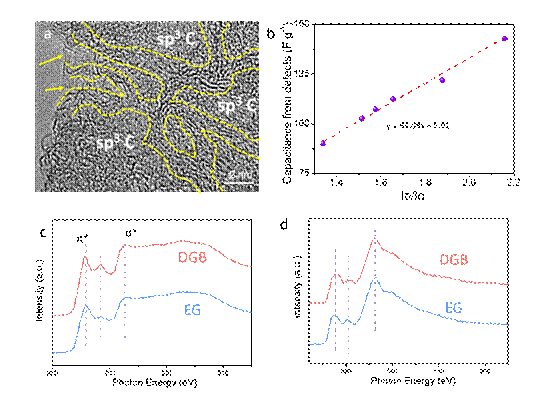| Boosting the Electrical Double-Layer Capacitance of Graphene by Self-Doped Defects through Ball-Milling |
| From: PublishDate:2020-07-31 Hits: |
Defect is one of the most important influence factors for the energy storage and electrocatalysis performance of carbon materials. The defect structure in carbons can be divided into foreign-doping (heteroatoms, functional groups, etc.) and self-doping (voids, vacancies, Stone-Wales, edges, etc.) defects. Particularly, self-doping defects are commonly considered to reduce the capacitive and rate performance of carbons due to the breaking of carbon skeleton and conductive network. Only a few researchers realized that self-doping defects may also improve the capacitive performance possibly through changing the charge distribution, or providing quantum capacitances. However, these works are primarily done based on either simulation methods or model products (such as single-layer graphene). The effect of defects towards electrochemical behaviors of carbons, the underlying influencing mechanisms, as well as the practical approaches to controllably engineer defect structures for designing advanced carbon materials are still unclear. The team prepared defective graphene blocks (DGB) from expanded graphene (EG) through ball-milling under Ar protection to controllably introduce self-doping defects. The results show that DGB with ultralow surface area exhibits higher capacitance than EG, and excellent rate capability. Self-doped defects can perform as active sites contributing double-layer capacitance. One unit increment of defect density (ID/IG) in DGB can provide a remarkably high capacitance of 114 F g-1. The specific areal capacitance of DGB is 7.91 F cm-2 including a self-doping defects contribution of 4.81 F cm-2, which is much higher than the theoretical value of graphene (0.21 F cm-2). Besides, the packing density (0.917 g cm-3) and volumetric performance of DGB are greatly enhanced due to the densification effect of ball-milling. This research has been published on April 10th, 2019 in Advanced Functional Materials.
Band structure of DGB using synchrotron radiation at BSRF. The peak between π* (~286 eV) and σ* (293 eV) in C1s spectra is corresponded to the sp3 bonding configuration, with a minor contribution may come from C-H at the edge or defective sites. This peak is obviously enhanced after ball-milling, further proving the increased defect density. The result is in well accordance with Raman and XPS. The research provides a simple ball-milling method to controllably introduce self-doping defects, which improve the electrical double-layer capacitance and maintain good rate and cycle performance of graphene. The density and volumetric performance are also improved due to the densification of ball-milling. This work reveal the influence and the underlying mechanism of self-doped defects towards electrochemical behaviors of carbons, providing a new thinking for designing high performance compact energy storage materials. Article: Yue Dong, Su Zhang, Xian Du, Song Hong, Shengna Zhao, Yaxin Chen, Xiaohong Chen, and Huaihe Song* Boosting the Electrical Double-Layer Capacitance of Graphene by Self-Doped Defects through Ball-Milling. Adv. Funct. Mater. 29 (2019), 1901127. |
|
|
| Chinese
- Metal-free efficient photocatalyst for stable visible water splitting——Top ten major scientific progresses in China in 2015
- The nano-resolution imaging platform was awarded the first rate prize of Beijing Science and Technology in 2014
- Beamline 1W1 of BSRF started to runoperate in the couplingparasitic mode of BEPCII
- Synthesis of High Performance Polymer Materials for Field Effect-Transistors
- Surfactant molecular aggregates in green solvents
- GIXRD has played an important role in the characterization of organic thin-film transistors
Science Highlights
Home /
Copyright © 2011 - 2012 Beijing Synchrotron Radiation Facility


